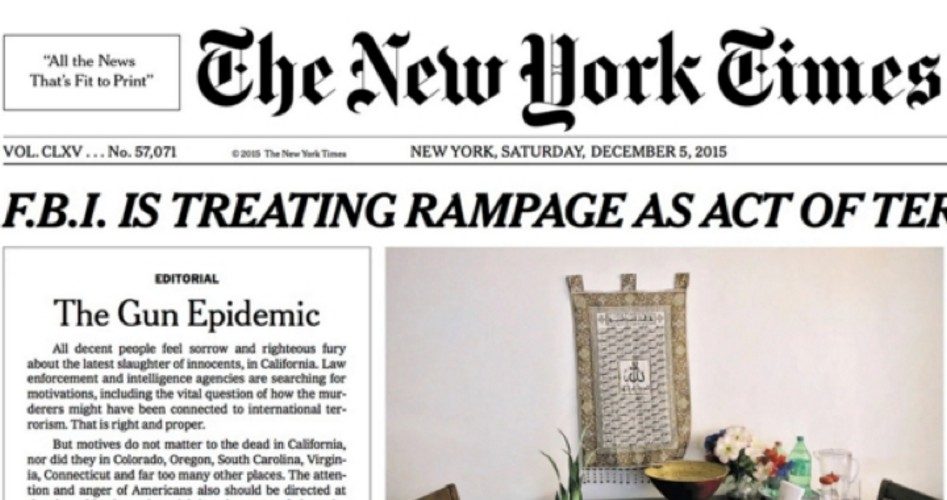
In its Saturday edition, the New York Times published a front-page editorial for the first time since 1920. The last time the Times gave one of its editorials this kind of prominence was when the editors criticized the Republican Party for nominating Warren Harding for president. Harding won anyway.
This time, according to Arthur Oaks Sulzberger, Jr., the publisher of the Times and the chairman of the New York Times Company (which owns the paper), it was necessary “to deliver a strong and visible statement of frustration and anguish about our country’s inability to come to terms with the scourge of guns.”
But although the front-page statement is certainly “strong,” it is undoubtly far less “visible” than Sulzberger would like because of the Times’ shrinking credibility in the eyes of the American public.
According to the Tmes editorial, Americans should direct “attention and anger … at at the elected leaders whose job is to keep us safe but who place a higher premium on the money and political power of an industry dedicated to profiting from the unfettered spread of ever more powerful firearms.”
The “elected leaders” the Times is complaining about are of course those who are standing in the way of the gun grab advocated by the Times and other anti-gun organs of the major media. But despite the propagandizing efforts, the American people are seeing more clearly than ever the dangers to their freedoms by an overweening executive branch of government seeking to disarm them in the name of fighting crime and terrorism. On Black Friday, more gun purchase background checks were run than on any day in history, and that was before the San Bernardino massacre and the president’s message on Sunday.
The Times also fumed that “it is a moral outrage and a national disgrace that civilians can legally purchase weapons designed specifically to kill people with brutal speed and efficiency,” adding, “These are weapons of war, barely modified and deliberated marketed as tools of macho vigilantism and even insurrection.” The online version of the front-page editorial included a link to an eariler Times editorial that took off after Republican senators who not once but twice defeated measures last week to expand background checks and strip people on the government’s “no-fly” list of their Second Amendment-guaranteed rights.
Of course, the Times does not view the Second Amendment as an insurmountable obstacle to its gun-grabbing agenda. Nor does the Times even view the clear wording and intent of this amendment as worthy of debate. In Saturday’s front-page editorial, the editors brazenly claim: “It is not necessary to debate the peculiar wording of the Second Amendment. No right is unlimited and immune from reasonable regulation.”
But what does the Times mean by “reasonable regulation”? The editors opine:
It is past time to stop talking about halting the spread of firearms, and instead reduce their number drastically — eliminating some large categories of weapons and ammunition.
And:
Certain kinds of weapons, like the slightly modified combat rifles used in [San Bernardino) California, and certain kinds of ammunition, must be outlawed for civilian ownership…. It would require Americans who own those kinds of weapons to give them up for the good of their fellow citizens.
Just how the more than 100 million households owning these firearms would be disarmed, the Times didn’t say. But it did reflect the Times’ liberal worldview that with enough government, society can be greatly improved.
David Warsh, upon leaving the Boston Globe as a staff writer in 2002 (when the Globe was owned by the New York Times Company), talked about what he referred to as “the new New York Times“:
The new New York Times … de-emphasizes balance…. Today its dominant overtones seem … to have become strident, intemperate, even undignified.
The transformation described by Warsh was largely the work of Howell Raines who was the Times’ Executive Editor from 2001 to 2003 whose left-liberal anti-gun views were similar to those of Sulzberger. Both favored “advocacy journalism,” the partisan and selective slant of stories, columns and editorials to promote their left-liberal agenda. According to Pat Buchanan, a senior advisor to Presidents Nixon, Ford and Reagan, Raines and Sulzberger were “fast converting the paper into a battering ram of the Left.”
When Raines resigned in 2003 following a scandal at the Times, he was replaced with Daniel Okrent who, in an editorial in the paper’s July 25, 2004 edition, asked rhetorically: “Is the New York Times a liberal newspaper?” And then answered, “Of course it is.”
But Americans are increasingly finding the “liberal” paper untrustworthy. In July, 2003 Rasmussen reported that 46 percent regarded the information reported in the Times was reliable and trustworthy. By February, 2008, just 24 percent of American voters held a “favorable opinion” of the New York Times, with 44 percent holding an “unfavorable opinion.”
As Stanley Kurtz, a former adjunct fellow with the conservative Hudson Institute, wrote, Sulzberger’s long-term plan was to target its liberal-left worldview to “the political-cultural elite (called “the knowledge audience”) throughout the world.” What the Times continues to do, however, is to address itself to an ever-diminishing audience as its strident liberal and anti-gun message falls on increasingly deaf ears.
A graduate of an Ivy League school and a former investment advisor, Bob is a regular contributor to The New American magazine and blogs frequently at LightFromTheRight.com, primarily on economics and politics. He can be reached at [email protected].



